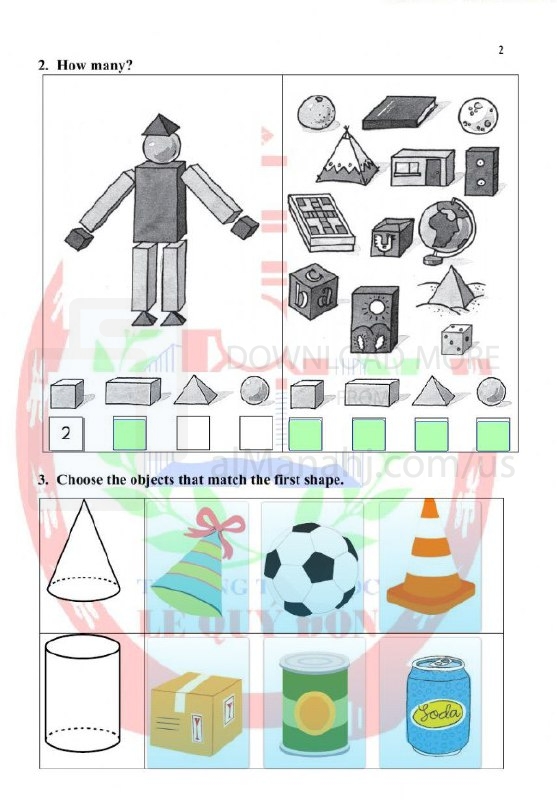File info: A worksheet about 3D shapes in math is an educational resource designed to help students understand and identify different three-dimensional geometric shapes. The worksheet typically includes information, examples, and various activities that cover topics such as identifying 3D shapes, recognizing their properties, calculating their surface area and volume, and exploring their real-world applications. Here's a description of what a worksheet about 3D shapes in math might include:
1. Introduction to 3D Shapes: The worksheet begins with an introduction to 3D shapes, also known as solid or three-dimensional shapes. It explains that these shapes have length, width, and height, and occupy space in three dimensions. It may include examples of common 3D shapes such as cubes, spheres, cylinders, cones, and pyramids.
2. Identifying 3D Shapes: The worksheet provides information on how to identify and name different 3D shapes. It may include descriptions and visual representations of each shape, emphasizing their unique characteristics and properties. This section may include labeling exercises or matching activities to reinforce students' understanding and recognition of various 3D shapes.
3. Properties of 3D Shapes: The worksheet explores the properties of different 3D shapes. It covers characteristics such as the number of faces, edges, and vertices each shape has. It may include tables or charts that summarize the properties of different shapes, allowing students to compare and contrast their features.
4. Surface Area and Volume: The worksheet introduces the concepts of surface area and volume of 3D shapes. It explains that surface area refers to the total area of all the faces of a shape, while volume refers to the amount of space enclosed by the shape. This section may include formulas and step-by-step instructions for calculating the surface area and volume of different 3D shapes. It may also include practice exercises for students to apply these formulas.
5. Real-World Applications: The worksheet explores real-life applications of 3D shapes. It provides examples of objects or structures that can be modeled using different 3D shapes, such as buildings, packaging, or geometric sculptures. This section may include questions or activities that prompt students to identify and analyze the 3D shapes present in these real-world scenarios.
6. Drawing and Building 3D Shapes: The worksheet includes activities that involve drawing or constructing 3D shapes. It may provide templates or instructions for creating paper or cardboard models of various 3D shapes. This section aims to enhance students' spatial visualization skills and their ability to manipulate and represent 3D objects on a 2D surface.
7. Review and Practice: The worksheet includes a review section that summarizes the key concepts and techniques covered in the worksheet. It may provide additional practice exercises that encompass a range of skills related to 3D shapes, such as identifying their properties, calculating their surface area and volume, or solving word problems involving these shapes.
8. Answer Key: The worksheet includes an answer key that provides correct answers or solutions to the exercises and problems. This allows students to check their work and self-assess their progress.
The purpose of the worksheet about 3D shapes in math is to help students develop a solid understanding of different three-dimensional shapes and their properties. By providing information, examples, and a variety of activities, the worksheet aims to enhance students' skills in identifying 3D shapes, recognizing their properties, calculating their surface area and volume, and applying these concepts to real-world situations. The worksheet encourages spatial reasoning, problem-solving, and mathematical thinking, allowing students to build a strong foundation in the geometry of 3D shapes. |
